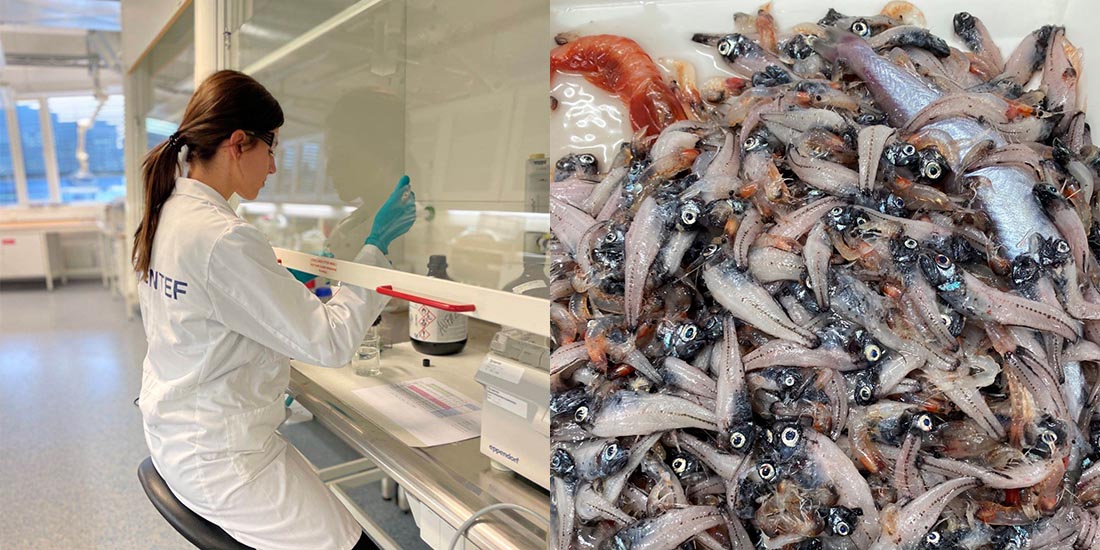Is there a new deep-sea fishery on the horizon?
Well, some researchers believe this is possible. Species living at depths between 200 and 1000 metres may be very valuable. However, harvesting them isn’t as easy as it might sound because, when taken on board, valuable catches change rapidly from pure gold to ashes.
The world’s oceans contain huge volumes of unexploited resource species living at depths between 200 and 1000 metres in the so-called mesopelagic zone. They have the potential to provide humans with valuable resources such as oils and proteins, and much more.
The innovation-driven SFI Harvest research centre, based at SINTEF Ocean, is currently working to find out exactly how these biomarine species can be exploited as the basis for a profitable and sustainable fisheries industry.
“What I’m doing now is virtually basic research”, says Maria Alquiza Madina, who is a marine technologist currently working at SINTEF Ocean on her doctorate in NTNU’s Biotechnology and Food Science Department. Her research work is entirely based on species sampled from the mesopelagic zone.
Rapid deterioration
“We see that all species caught from these depths deteriorate very rapidly”, says Madina. “This is due to enzymes that break the bodies down, turning them very quickly into fish soup”, she says.
One of the puzzles she is working on is to find out how it might be possible to stabilise mesopelagic catches before this deterioration sets in. This is essential in order to allow time to separate the different components of the catch prior to extracting the proteins and oils in their purest and highest quality states.
“What is so special about mesopelagic species is that they contain very high-quality raw materials that can be used to manufacture products that can be sold at high prices at pharmacies and health food outlets.
Huge rewards
Traditional fisheries have harvested species in the open water masses of the shallower pelagic zone. As a result, we have accumulated a great deal of knowledge about species living at depths of 200 metres and less. Resource species at deeper levels, however, have remained largely unexploited.
Estimates indicate the presence of huge volumes of such species in the mesopelagic zone, and scientists working in this field are trying to find out how much of this resource can be exploited without disturbing existing ecosystems.
The introduction of a new fishery may serve to relieve the pressure on overfished species and reduce the area of agricultural land required for the production of soya bean meal used as animal feed. Researchers believe that in spite of the difficulties involved, the potential rewards are so great that it is well worth working towards finding a solution.
“What is so special about mesopelagic species is that they contain very high-quality raw materials which can be used to manufacture products that can be sold at high prices at pharmacies and health food outlets”, explains Madina.
Mixed catches demand new technologies
Many questions need to be answered before a fishery dedicated to exploiting the mesopelagic zone can become a reality. First of all, we need to find out where and how such activities can be carried out. But the major concern being addressed by researchers is what happens after a catch is brought on board. How do we extract the high-quality nutrient raw materials in their purest state?
Mesopelagic species vary greatly in their nutrient content. Jellyfish consist almost entirely of just protein, salt and water, whereas the zooplankton copepod Calanus contains more than 60 per cent marine oils. Some smaller fish and shrimp species are packed with essential omega-3 fatty acids. These species live in close association with each other but are very dissimilar.
“We see that all species caught from these depths deteriorate very rapidly. This is due to enzymes that break the bodies down, turning them very quickly into fish soup.
The lack of homogeneity in mesopelagic catches is just one of the challenges that Madina and any future industry will have to come to terms with.
“Stabilisation (the prevention of deterioration) and processing would be much easier if we could simply catch one species at a time”, says Madina. “However, I doubt that it will ever be realistic to develop harvesting methods that will avoid mixed catches. This means developing the best technologies we can for getting around this problem”, she says.
Pain threshold
Madina is working to identify and describe each of the species encountered in the mesopelagic zone, some of which we know very little about. In general, however, researchers believe that these species offer a major potential for exploitation.
“The nutrient raw materials extracted from mesopelagic species can be used for many different purposes, but in all cases, catches must first be stabilised and processed in order to extract the pure substances”, explains Madina. “In an ideal world, in order to ensure optimal quality of the raw materials, this will take place on board fisheries vessels immediately after a catch is brought on board. Since this will involve major investments in fleets of factory vessels, we’re also looking into the possibility of stabilising catches on board and then bringing them onshore for processing”, she says.
An alternative to stabilisation on the vessels is simply to freeze catches as soon as they are taken on board. Madina is working to identify the ‘pain thresholds’ in terms of critical freezing times and temperatures.
“We’ve been attempting to transfer knowledge about these technologies from the traditional pelagic fisheries sector”, she says. “However, due to the greater variation in the composition of catches, and the higher levels of enzyme activity, only very few of our familiar techniques have proved to be directly transferable”, says Madina.
An acceptable plan B
If the knowledge and a technology making it possible to extract valuable omega-3 fatty acids before catch deterioration sets in cannot be found, the raw materials will start to break down. This will mean that mesopelagic catches can only be used as raw materials for the production of fish meal. There is no doubt that this will offer lower levels of profitability than oil and protein extraction, but does not necessarily mean that a fish meal industry is without interest.
The feed industry will always require fish meal and, according to researchers at SINTEF Ocean, production based on mesopelagic species represents an exciting possibility. One way or another, if they succeed, this may be the beginning of an entirely new fisheries industry.




